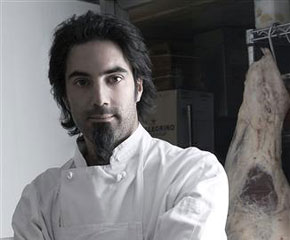It means Cutrara has abandoned exotic ingredients from around the world in favour of an ever-changing menu boasting fresh, seasonal produce and local farm animals butchered and prepared in-house.
Q: Taking a fresh and local approach sounds simple, but I imagine it can get pretty complicated.
MC: “It can be. Our menu changes almost every day. We’re very flexible in what we work with, but we’re very limited too. For example, we have a limited portion of each item because there are only two strip loins in a cow. That equates to 30 portions of New York strip loin. And once it runs out, that’s it. It goes along with the idea of sustainability.”
Q: So instead of devising a menu and then tracking down the ingredients, you look at what’s available locally and take it from there?
MC: “Exactly. So for example, yesterday’s first course was a salad of flowers and sprouts. Just being the time of year that it is, nothing’s available. There’s asparagus, which is finishing and radishes, which are done. Now what’s happening is plants are flowering to produce the fruits of summer. But at the moment, what’s available is sprouts and flowers &ndash and lots of bees.”
Q: You don’t like being labelled as a steakhouse &ndash why is that?
MC: “Well, there’s a preconception that comes with that &ndash that you’ll have New York strip loin, tenderloins and sirloin. And if you’re cooking the whole animal, you’re very limited in how many of those items you can have. We want to present beef as beef. So what that would mean is we have a beef plate, and that would be composed of meat from different parts of the animal that we prepare the best way we know how. A farmer last night said something very poignant to me &ndash he said, ‘I don’t raise tenderloins, I raise cows.’ That’s a very important idea to think about.”
Q: Was there a turning point that made you take this approach to your restaurant?
MC: “I was on a fishing trip in Salt Spring island in British Columbia with my son Max and I was talking with an organic farmer. We talked about politics and economy, farming, everything. I caught five sockeye salmon and I traded three of them for some of the stuff he produced &ndash turnips, carrots, scampi. After I cooked everything it occurred to me I’d never had a meal like that before, where I knew exactly where everything came from. And I thought I’d probably never have a meal like that again.”
Q: Tell me about ‘Farmers Night’ here at the restaurant.
MC: “We make a five-course menu based on ingredients from a local farm and we invite the farmers to come to the restaurant to talk about how they raise their animals and grow their produce.”
Q: That must bring a new consciousness to the food you’re eating.
MC: “Well, we try not to talk about slaughtering chickens while people are eating, but that’s the reality of it. There’s a connection between food and eating that a lot of people ignore. It should be acknowledged.”

